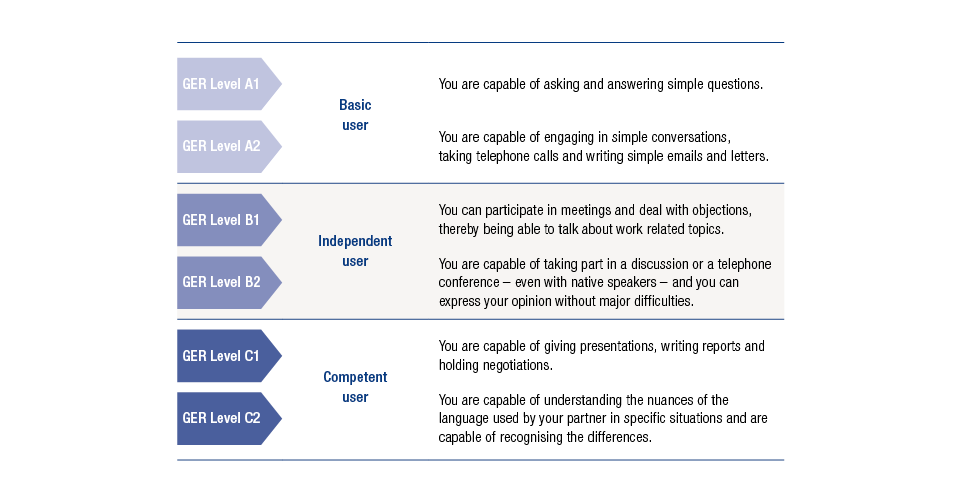The Common European Framework of Reference for Languages
Language textbooks and linguistic training materials in the European Union are based on the Common European Framework of Reference for Languages (CEFR).
What is the CEFR?
The CEFR is a framework for defining linguistic capabilities which enables the most precise possible classification of your abilities, and also helps to tailor services in the languages sector more accurately to the individual's needs.
The CEFR levels of competence serve to define the individual's basic level of grammar and vocabulary. It makes textbooks easier to compare. It also enables the level of learning of different groups to be described clearly and in a universally understood way. The standards apply across languages, and are an indication of a language student's capabilities.
The Common European Framework of Reference differentiates between levels of competence, each of which is often sub-divided into a more precise definition.

The six levels of competence of the CEF
Elementary use of language
- A1 – The participants can understand and use familiar, day-to-day expressions and simple phrases, based on the satisfaction of needs. They are able to introduce themselves an other people, ask other people questions about themselves – e g. where they live, who they know or what things they have – and respond to this type of question. They are able to communicate in simple terms if the other person speaks slowly and clearly, and is prepared to help.
- A2 –The participants can understand frequently used expressions and phrases, which are linked to areas of most immediate relevance. (E.g. Information about a person or family, shopping, work or the surrounding area). They are able to communicate in routine situations that concern the simple and direct exchange of information about familiar and common subjects. They are able to describe where they come from and their education, their immediate environment and things in relation to their immediate needs.
Independent use of language
- B1 – The participants can understand the main points of a conversation, providing the standard language is being used and is about familiar topics from work, school, freetime They are able to handle most situations that occur when travelling in the linguistic area. They are able to express themselves very simply and coherently on familiar topics and personal areas of interest. They are able to report on their experiences and events, describe their dreams, hopes and ambitions, and provide brief justifications or explanations of their plans and visions.
- B2 – The participants can understand the main ideas of complex texts on concrete and abstract topics in their field of expertise and technical discussions They are thus able to communicate spontaneously and fluently such that a normal conversation with native speakers is very possible with no great effort on either side. Students are able to express themselves clearly and in detail on a wide range of subjects, explain their stance on a current issue and give the advantages and disadvantages of different options.
Competent use of language
- C1 – The participants can understand a wide spectrum of longer and more challenging texts and also grasp implicit meanings They are able to express themselves spontaneously and fluently without having to obviously search for words. They are able to use the language effectively and flexibly in their social and professional life as well as in their training or education. They are able to express themselves clearly and in a structured and detailed way on complex issues. They are also able to use various methods of text association appropriately.
- C2 – Participants can effortlessly understand practically everything they read and hear. They can summarise information from various written and verbal sources and so present justifications and explanations coherently. They can express themselves spontaneously, very fluently and precisely, and also make clear the finer nuances of meaning in regard to more complex subjects.